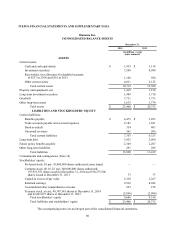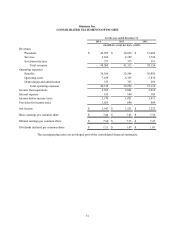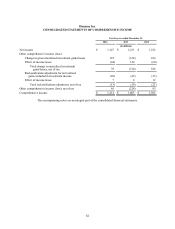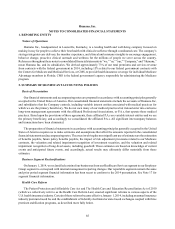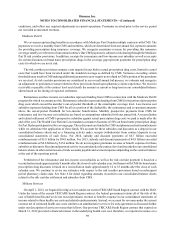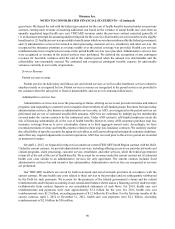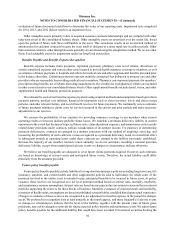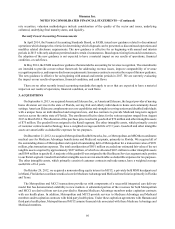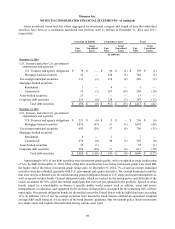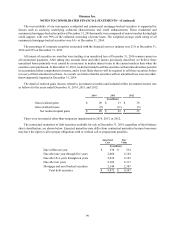Humana 2014 Annual Report Download - page 97
Download and view the complete annual report
Please find page 97 of the 2014 Humana annual report below. You can navigate through the pages in the report by either clicking on the pages listed below, or by using the keyword search tool below to find specific information within the annual report.Humana Inc.
NOTES TO CONSOLIDATED FINANCIAL STATEMENTS—(Continued)
89
conditions, and reflect any required adjustments in current operations. Premiums received prior to the service period
are recorded as unearned revenues.
Medicare Part D
We cover prescription drug benefits in accordance with Medicare Part D under multiple contracts with CMS. The
payments we receive monthly from CMS and members, which are determined from our annual bid, represent amounts
for providing prescription drug insurance coverage. We recognize premiums revenue for providing this insurance
coverage ratably over the term of our annual contract. Our CMS payment is subject to risk sharing through the Medicare
Part D risk corridor provisions. In addition, receipts for reinsurance and low-income cost subsidies as well as receipts
for certain discounts on brand name prescription drugs in the coverage gap represent payments for prescription drug
costs for which we are not at risk.
The risk corridor provisions compare costs targeted in our bids to actual prescription drug costs, limited to actual
costs that would have been incurred under the standard coverage as defined by CMS. Variances exceeding certain
thresholds may result in CMS making additional payments to us or require us to refund to CMS a portion of the premiums
we received. As risk corridor provisions are considered in our overall annual bid process, we estimate and recognize
an adjustment to premiums revenue related to these provisions based upon pharmacy claims experience. We record a
receivable or payable at the contract level and classify the amount as current or long-term in our consolidated balance
sheets based on the timing of expected settlement.
Reinsurance and low-income cost subsidies represent funding from CMS in connection with the Medicare Part D
program for which we assume no risk. Reinsurance subsidies represent funding from CMS for its portion of prescription
drug costs which exceed the member’s out-of-pocket threshold, or the catastrophic coverage level. Low-income cost
subsidies represent funding from CMS for all or a portion of the deductible, the coinsurance and co-payment amounts
above the out-of-pocket threshold for low-income beneficiaries. Monthly prospective payments from CMS for
reinsurance and low-income cost subsidies are based on assumptions submitted with our annual bid. A reconciliation
and related settlement of CMS’s prospective subsidies against actual prescription drug costs we paid is made after the
end of the year. The Health Care Reform Law mandates consumer discounts of 50% on brand name prescription drugs
for Part D plan participants in the coverage gap. These discounts are funded by CMS and pharmaceutical manufacturers
while we administer the application of these funds. We account for these subsidies and discounts as a deposit in our
consolidated balance sheets and as a financing activity under receipts (withdrawals) from contract deposits in our
consolidated statements of cash flows. For 2014, subsidy and discount payments of $6.7 billion exceeded
reimbursements of $5.8 billion by $945 million. For 2013, subsidy and discount payments of $4.8 billion exceeded
reimbursements of $4.6 billion by $154 million. We do not recognize premiums revenue or benefit expenses for these
subsidies or discounts. Receipt and payment activity is accumulated at the contract level and recorded in our consolidated
balance sheets in other current assets or trade accounts payable and accrued expenses depending on the contract balance
at the end of the reporting period.
Settlement of the reinsurance and low-income cost subsidies as well as the risk corridor payment is based on a
reconciliation made approximately 9 months after the close of each calendar year. Settlement with CMS for brand name
prescription drug discounts is based on a reconciliation made approximately 14 to 18 months after the close of each
calendar year. We continue to revise our estimates with respect to the risk corridor provisions based on subsequent
period pharmacy claims data. See Note 6 for detail regarding amounts recorded to our consolidated balance sheets
related to the risk corridor settlement and subsidies from CMS.
Military Services
On April 1, 2012, we began delivering services under our current TRICARE South Region contract with the DoD.
Under the terms of the current TRICARE South Region contract, the federal government retains all of the risk of the
cost of health benefits and we do not record premiums revenue or benefits expense in our consolidated statements of
income related to these health care costs and related reimbursements. Instead, we account for revenues under the current
contract net of estimated health care costs similar to an administrative services fee only agreement as discussed further
under our description of services revenue that follows. Our previous TRICARE South Region contract that expired on
March 31, 2012 provided a financial interest in the underlying health care cost; therefore, we reported revenues on a



